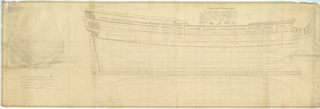
HMS Cornwall was an 80-gun, third rate, ship of the line built for the Royal Navy in the 1690s. She served in the War of the Grand Alliance, and in her first year took part in the Battle of Barfleur and the action at La Hougue.

HMS Cornwall was a 74-gun third-rate Vengeur-class ship of the line built for the Royal Navy in the 1810s. She spent most of her service in reserve and was converted into a reformatory and a school ship in her later years. The ship was broken up in 1875.
Bristol was a British 44-gun fourth-rate frigate, originally built for the navy of the Commonwealth of England during the 1650s. She was taken over by the Royal Navy after the Restoration of the monarchy in 1660, and was thereafter styled HMS Bristol. The ship participated in multiple battles during the Anglo-Spanish War of 1654–60, and the Second and Third Anglo-Dutch Wars.

HMS Northumberland was a 70-gun third rate ship of the line of the Royal Navy, built at Plymouth Dockyard to the draught specified by the 1745 Establishment, and launched on 1 December 1750.

HMS Northumberland was a 70-gun third-rate ship of the line of the Royal Navy, built at Deptford Dockyard and launched in 1705.

HMS Bombay was a 74-gun third rate ship of the line of the Royal Navy, launched on 28 March 1808 at Deptford.

HMS Gloucester was a 74-gun, third rate Vengeur-class ship of the line built for the Royal Navy in the 1810s. She played a minor role in the Napoleonic Wars and was cut down into a 50-gun fourth rate frigate in 1831–32. The ship was converted into a receiving ship and broken up in 1884.

Loyal London was an 80-gun second-rate ship of the line of the Royal Navy, launched on 10 June 1666 at Deptford Dockyard with a burthen of 1,236 tons. She was established with 80 guns comprising 22 cannon-of-seven, four demi-cannon, 26 culverins and 28 demi-culverins; in July 1666 this was raised to 92 guns, comprising seven cannon-of-seven, 19 demi-cannon, 28 culverins, 26 12-pounders and 12 demi-culverins.
Merhonour was a ship of the Tudor navy of England. It was built in 1590 by Mathew Baker at Woolwich Dockyard, and was rebuilt by Phineas Pett I at Woolwich between 1612 and 1615, being relaunched on 6 March 1615 as a 40-gun royal ship. It was then laid up at Chatham, only briefly returning to service in the 1630s. It was nevertheless considered to be one of the fastest ships in the Navy.

HMS Salisbury was a 50-gun fourth rate ship of the line of the Royal Navy, built by Richard and James Herring at Baileys Hard on the Beaulieu River in Hampshire, England and launched on 18 April 1698.
HMS Kentish was a 40-gun fourth-rate frigate of the Commonwealth of England Navy, built by contract at Deptford and launched in November 1652.
HMS Exeter was a 70-gun third rate ship of the line of the English Royal Navy, built by contract of 20 February 1678 by Henry Johnson at Blackwall Yard and launched in March 1680.
HMS Gloucester was a 60-gun fourth rate ship of the line built for the Royal Navy during the 1690s. She spent most of her career in the West Indies and participated in the 1701–15 War of the Spanish Succession. The ship was hulked in 1708 and broken up in 1731.

HMS Swiftsure was a 70-gun third-rate ship of the line of the Royal Navy, launched in 1755 and in active service during the Seven Years' War. After a distinguished career at sea she was decommissioned in 1763 and sold into private hands ten years later.
HMS Falmouth was a 50-gun fourth rate ship of the line built for Royal Navy in the 1690s. The ship participated in several battles during the Nine Years' War of 1688–97 and the War of the Spanish Succession (1701–1715), including the action of August 1702. She was captured by the French in 1704.

HMS Exmouth was a 91-gun screw propelled Albion-class second-rate ship of the line of the Royal Navy.
HMS Falmouth was a 50-gun fourth-rate ship of the line built for the Royal Navy in the first decade of the 18th century. The ship participated in several battles during the War of the Spanish Succession (1701–15) and the War of Jenkins' Ear (1739–48).

HMS Gloucester was a 50-gun fourth-rate ship of the line built for the Royal Navy in the 1710s. She participated in the 1701–15 War of the Spanish Succession. The ship was burned to prevent capture after she was damaged in a storm during Commodore George Anson's voyage around the world in 1742.

HMS Gloucester was a 50-gun fourth rate ship of the line built for the Royal Navy in the 1740s. She participated in the 1740–48 War of the Austrian Succession, capturing four French privateers. The ship was broken up in 1764.

HMS Victor Emmanuel was a screw-propelled 91-gun second-rate ship of the line of the Royal Navy, originally launched as HMS Repulse, but renamed shortly after being launched.













